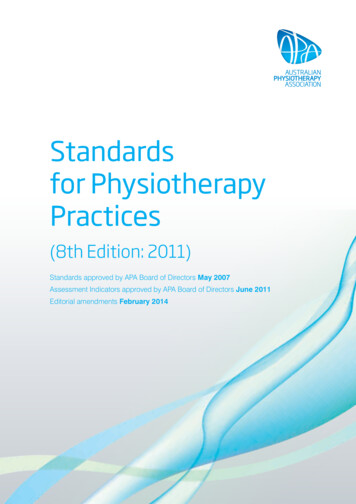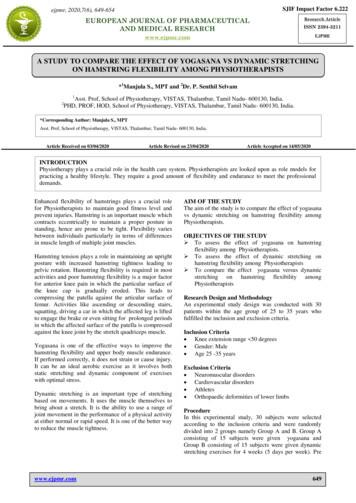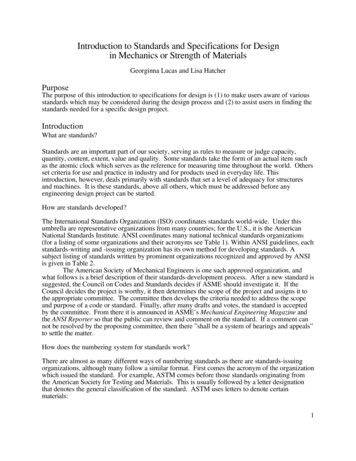
Transcription
Standardsfor PhysiotherapyPractices(8th Edition: 2011)Standards approved by APA Board of Directors May 2007Assessment Indicators approved by APA Board of Directors June 2011Editorial amendments February 2014
AcknowledgementsThe Australian Physiotherapy Association (APA) Standards for Physiotherapy Practices, 8th Edition2011,builds on the Association’s proud history of commitment to quality physiotherapy and the work of all thosewho have contributed to the development of each successive edition of the standards.APA appreciates the contribution that many people have made to this edition of the standards. In particular,the APA would like to thank: physiotherapists in accredited practices for their ongoing commitment to quality primary healthcare accreditation surveyors for their invaluable knowledge and expertise individual physiotherapists who have commented on successive drafts and participated in field testing stakeholder organisations for useful practical and strategic suggestions APA members and staff who contributed to the 2004 independent review of the Association’s formerQuality Endorsement Program Physiotherapy Business Australia who established the original accreditation program for physiotherapypractices and who have generously supported the ongoing development of both the program andthe standards Board members and staff of Quality in Practice Pty Ltd for their expert advice Royal Australian College of General Practitioners whose standards for General Practices (3rd edition)have provided useful inspiration Ms Clare Barr for her comprehensive review of accreditation standards, both national and international,during a student placement at the APA.The APA would like to acknowledge members of the working party entrusted by the Association’s Board of Directorsto this work:20071Ms Sandie Chapman-O’Meara, SurveyorMs Genevieve Dwyer, APA DirectorMs Sue Jones, former APA DirectorMs Rose-Anne Kelso, former APA DirectorMs Jennifer Lake, APA General Manager (Victoria and Quality Practice)Mrs Elizabeth Moorfield, Chair of the former APA Quality Endorsement Program.2011Mr Jonathon Kruger, APA General Manager—Advocacy and International Relations DivisionMr Neil Sherburn, Accreditation SurveyorMr Marcus Dripps, APA DirectorAPA Standards for Physiotherapy Practices 8th Edition 2011
NoteThe APA has approved two pathways towards accreditation against these standards: entry level accreditationor full accreditation.Practices that choose to commence their accreditation journey via the entry level accreditation pathway must comply withall non-asterixed indicators of the APA standards. Practices will be required to provide documentary evidence to enablea desktop assessment to be undertaken by a peer surveyor to achieve accreditation against the entry level standards.Practices that choose full accreditation must comply with all APA standards, including those with an asterix.Assessment against the full suite of standards will involve a desktop assessment as per the entry level process,supplemented by an on-site assessment undertaken by a peer surveyor. It is proposed that full accreditation willbe available from 2013.2
Contents3Foreword5Category 1Rights and needs of clients7Standard 1.1Criterion 1.1.1Criterion 1.1.2Criterion 1.1.3Criterion 1.1.4Criterion 1.1.5Human rightsRespectPrivacyInformed consentClient communicationCulturally appropriate care779101314Standard 1.2Criterion 1.2.1Criterion 1.2.2Client-centred careCollaborative goal settingHealth promotion151516Category 2Practice services17Standard 2.1Criterion 2.1.1Client health recordCompliance1717Standard 2.2Criterion 2.2.1Criterion 2.2.2Coordination of careReferralCommunication202021Standard 2.3Criterion 2.3.1Access to servicesResponsive healthcare2222Category 3Practice managementStandard 3.1Criterion 3.1.1Criterion 3.1.2Criterion 3.1.3Business systemsStrategic planOperationsPractice communication25252627Standard 3.2Criterion 3.2.1Criterion 3.2.2Human resource managementHuman resource management systemsCredentials282829Standard 3.3Criterion 3.3.1Criterion 3.3.2Criterion 3.3.3Criterion 3.3.4Criterion 3.3.5Health information systemsConfidentiality and privacyCollectionSecurityUse and disclosureAccess313132333436Standard 3.4Criterion 3.4.1Criterion 3.4.2Criterion 3.4.3Criterion 3.4.4Risk managementRisk managementOccupational health and safetyManual handlingEmergency systems3737394142APA Standards for Physiotherapy Practices 8th Edition 201125
Standard 3.5Criterion 3.5.1Improving practice managementQuality improvement4343Category 4Physical environmentStandard 4.1Criterion 4.1.1Criterion 4.1.2Criterion 4.1.3FacilitiesPractice environmentCompliancePractice access45454648Standard 4.2Criterion 4.2.1EquipmentEquipment safety and maintenance4949Standard 4.3Criterion 4.3.1Infection controlInfection control standards5050Category 5Quality physiotherapyStandard 5.1Criterion 5.1.1Criterion 5.1.2Criterion 5.1.3Clinical best practiceRecognised best practiceOutcome measuresClinical risk management51515253Standard 5.2Criterion 5.2.1Professional standardsProfessional conduct5555Standard 5.2Criterion 5.2.2Criterion 5.2.3Professional standardsContinuing professional developmentClinical supervision575758Standard 5.3Criterion 5.3.1Criterion 5.3.2Quality improvementClient feedbackImproving clinical care5959604551Summary of contact details61References654
ForewordWhat are the APA Standards for PhysiotherapyPractices?The APA Standards for Physiotherapy Practicesare standards developed by physiotherapists forphysiotherapists. The standards are owned by the APAand are designed to help physiotherapy practices inthe private sector deliver safe, high quality healthcareand embrace continuous quality improvement as goodbusiness practice.There are five categories of standards, which cover: rights and needs of clients practice services practice management physical environment quality physiotherapy.Client feedback—a lynchpin in the quality cycleOngoing learning underpins the APA Standards forPhysiotherapy Practices. This learning is encapsulatedin a quality cycle that moves from planning to action,evaluation and feedback, then back to planning—and so the cycle continues.Client feedback is a pivotal component of the qualityenhancement process and is a fundamental buildingblock in the day-to-day work of improving clinical careand practice operations. The ultimate quality test forany physiotherapy practice is a client’s satisfactionwith their health outcomes. And this test lies at the heartof a successful accreditation system.How can a practice use the standards?Each category contains guidance material to helppractices interpret thestandards, as well as resourcematerial to assist practices in complying with each setof mandatory assessment indicators.5Why are the APA Standards for PhysiotherapyPractices important?The APA standards provide a basis for excellence inclinical care and practice operations—excellence whichjustifies community trust in the expertise and integrityof physiotherapists.The standards reflect hallmark qualities of thephysiotherapy profession in Australia – respect forthe individual, professional accountability,evidence-based practice, sound risk managementand ongoing learning.For the first time, APA Standards for PhysiotherapyPractices include a set of standards that relatespecifically to the quality of clinical care. This puts thephysiotherapy profession in Australia at the frontlineof safety and quality in primary health care.APA Standards for Physiotherapy Practices 8th Edition 2011The APA Standards for Physiotherapy Practices is availablein the public domain as an important indicator ofbenchmark expectations on safe, high quality healthcareand sound practice operations.Physiotherapy practices in the private sector can usethe APA standards to self-assess the safety and qualityof primary healthcare they provide to the Australiancommunity, and to self-assess the efficiency andeffectiveness of their practice operations.Practices can also go a step further and seekformal accreditation against the APA Standardsfor Physiotherapy Practices.Why accredit?Accreditation against the APA Standards for PhysiotherapyPractices is the ultimate formal acknowledgement ofa practice’s commitment to safe, high quality healthcare.Accreditation sends important messages to the community,clients, peers, medical colleagues, third party purchasersand key decision makers in the Australian health caresystem that physiotherapists are seriously committedto excellence in primary health care.
How does accreditation work?Managed by expertsAccreditation against the APA Standards for PhysiotherapyPractices is managed by Quality in Practice (QIP),a subsidiary of Australian General Practice AccreditationLimited. This means physiotherapy practice accreditationis managed by a market leader with specialist expertiseand is awarded independently of the custodian of thestandards, the Australian Physiotherapy Association.Comprehensive practical supportQuality in Practice provides comprehensive practicalsupport to physiotherapy practices preparingfor accreditation and offers customised software(Accreditation Pro) to minimise the level of administrationinvolved in the accreditation process.Feedback on the 8th editionThe Association is keen to ensure that APA Standardsfor Physiotherapy Practices is a useful day-to-day toolfor evaluating and improving the safety and quality ofprivate sector physiotherapy as well as the efficiencyand effectiveness of practice operations.To ensure the 8th edition standards set the quality barat the appropriate level, the APA is committing toreviewing the standards regularly to make certainthey continue to reflect the highest standard expectedof contemporary physiotherapy practices.Marcus DrippsNational PresidentAustralian Physiotherapy Association6
Category 1Standard 1.1Rights and needs of clientsHuman rightsThe practice respects the rights and dignity of clients.Criterion 1.1.1 RespectClients receive respectful care and are not discriminatedagainst on the basis of their age, gender, ethnicity, beliefs,sexual preference or health status.GuidanceRespect for clientsClients have the right to be treated in a manner thatrespects their individuality. Clients, their families andcarers should be treated courteously. There should befull recognition of client needs, culture and beliefs in allaspects of communication, assessment and intervention.7At a practical level, health professionals should givespecial consideration to the inherent sensitivity in theclient-practitioner relationship where hands-on treatmentis involved.Where a client is particularly vulnerable (such as a clientwith mental health problems or a client who is a minor)and/or there is potential for the client-practitionerrelationship to be particularly sensitive, the practicemay choose to demonstrate extra respect for the clientby scheduling appointments for a time when others arein the practice or, with the client’s consent, have a thirdparty present.Practice staff should have good interpersonal skillsto work with clients, their families and carers in arespectful way.Client responsibilitiesFor the best possible health outcomes, the clientand the clinical team need to share information openly.Clients need to provide the clinical team with all relevantinformation about their presenting condition as wellas any other information about their health that mayaffect options for intervention. Clients should treatpractice staff and other clients with respect, observepractice policies including the practice fee schedule,and communicate their needs, expectations and concernsin a timely manner.APA Standards for Physiotherapy Practices 8th Edition 2011Anti-discriminationPractices need to be aware of the requirements ofthe Federal Disability Discrimination Act (1992) and anyother state and territory Disability Services Acts andEqual Opportunity Acts which prohibit the discriminatorytreatment of people based on their age, gender, ethnicity,beliefs, sexual preference or health status.Practice staff should understand that information theycommunicate or record about clients should not bederogatory, prejudiced, or prejudicial. Such statementsmay have serious consequences for client intervention,compensation and other legal matters, and maycontravene anti-discrimination legislation.Client rightsClients have the right to know the qualification of theirtreating health professional. Clients have the right to seethe physiotherapist of their choice, refuse interventionor seek a further opinion. Practices need to recordsuch information in the client health record includingan explanation of the action taken. If a client elects togo to another health professional, appropriate healthcareinformation should be provided if requested.Health professional rightsPhysiotherapists and other health professionals havethe right to refuse to provide a service where there arereasonable and non-discriminatory reasons for doing so.Health professionals have the right to discontinueintervention when a client has behaved in a threateningor violent manner, or there has been some othercause for a significant breakdown of the therapeuticrelationship. The practice should have a policy fordiscontinuing a client’s episode of care and the policyshould include safety measures to protect staff,assistance with ongoing care including referral to otherhealth professionals, and clear documentation of thecircumstances leading to the discontinuation of care.Health professionals have the right to protect theirprofessional reputations and to take reasonable stepsto avoid any possible misunderstanding of professionalboundaries.Client informationThe practice needs to provide written information abouta client’s right to see the physiotherapist of their choice,obtain a second opinion, refuse an intervention, providefeedback or make a complaint. The practice may also
like to provide general information about common clinicalconditions, health promotion and injury/illness material,and diagrams for activities such as home exerciseprograms.The information can be provided to clients in a variety offormats, including a client information sheet, brochuresor flyers.Communication with clientsAssessment indicatorsA. The practice has a policy that provides writteninformation about a client’s rights. This may includethe right to see the physiotherapist of their choice,obtain a second opinion, refuse an intervention,provide feedback or make a complaint.B. There is a policy for discontinuing a client’s episodeof care.The practice should promote a culture of opencommunication at all stages of client care.Good communication is a vital factor in the delivery ofquality healthcare. It is also essential in the day-to-daymanagement of risk and compliance.Further informationTailored communicationThe Australian Human Rights Commission hasinformation about human rights and people withspecial needs.humanrights.gov.auCommunication which is tailored to the individual needsof a client is fundamental to an effective client-practitionerrelationship built on mutual trust and respect. Tailoredcommunication includes spoken and written messages,body language, courtesy, active listening and a generalattitude that is sensitive to a client’s needs.Practice staff should adapt their communication toaccommodate particular client attributes such as firstlanguage, culture, age, gender, cognitive ability orhealth status.Communication supportA client may elect to have a third party supporterto facilitate communication during or related toa consultation.Client feedbackThe practice must actively seek client feedback.Such feedback forms an integral component of theAPA Standards for Physiotherapy Practices includingrespect for the rights and dignity of clients. Feedbackmay be solicited in a variety of ways including a clientquestionnaire. Client feedback is covered in more detailin criterion 5.3.1.The Australian Charter of Healthcare Rightsis available on the website of the Australian Commissionon Safety and Quality in Healthcare.safetyandquality.gov.auThe APA Code of Conduct provides a practicalinterpretation of client rights.physiotherapy.asn.auState and Territory Health Services Commissioners/Health Complaints Commissioners provide informationfor health consumers about making a complaint(see Summary of contact details).The APA consumer brochure What to Expect fromYour Physiotherapist is available on the APA website.physiotherapy.asn.auThe Physiotherapy Board of Australia has developedcodes and guidelines to provide guidance to elines.aspx8
Category 1Standard 1.1Rights and needs of clientsHuman rightsThe practice respects the rights and dignity of clients.Criterion 1.1.2 PrivacyThe practice is committed to protecting client privacy.GuidanceClients have a right to expect privacy in the provisionof their healthcare. The practice needs to have policiesabout client privacy and these policies must be upheldby practice staff.Identify individual privacy needs9Each client has a unique need for privacy during aconsultation. This need may vary according to personalpreference, natural modesty, the type of care beingprovided and the client’s familiarity with the intervention.For example, the privacy needs of a client may besignificantly different if the consultation involvesthe treatment of a sports injury versus continencemanagement.In determining the individual privacy needs of a client,practice staff should avoid stereotyping and generalising.Visual privacyIf a client needs to disrobe for a particular intervention,the health professional must provide a clear explanationof ‘adequate undress’ and the reason it is important.The health professional should offer suitable cover(such as a gown, shorts or drape) if it is necessaryto protect the client’s dignity.In some circumstances, the client should be invitedto disrobe behind a privacy screen. Alternatively,the health professional may turn their back or chooseto leave the room while a client disrobes.Where a client is particularly vulnerable and/or thereis potential for the client-practitioner relationship to beparticularly sensitive, the health professional may seekthe client’s consent to have a third party present ina chaperone role if the client needs to disrobe for anintervention.APA Standards for Physiotherapy Practices 8th Edition 2011Auditory privacyThe practice should have at least one area that offerssatisfactory auditory privacy so that discussions witha client can be conducted in private. In practiceswith curtained treatment areas, this may mean thatdiscussions at the commencement of a consultationneed to be conducted in private in a separate area.It is particularly important that discussion and telephonecommunication at the reception area be conducteddiscreetly, in the interests of respecting clientsand protecting the privacy of health information.Similarly, discussions between health professionalsabout a client should be conducted discreetly andshould not take place in the presence of other clientsor administrative staff.Assessment indicatorsA. Physiotherapists and other staff can describe howthey identify the individual privacy needs of a client.B. The practice has a policy which describes howthe privacy needs of individual clients are met.
Standard 1.1Human rightsThe practice respects the rights and dignity of clients.Criterion 1.1.3 Informed consentClients are given sufficient information to enable themto make informed decisions about their health care.GuidanceIntelligible informationClients need sufficient information to make appropriatedecisions about their own health care. Health professionalsneed to provide adequate information about theimportance, benefits and risks of proposed healthcarein language that is tailored to the individual needs ofa client.apply and the costs incurred for late cancellations orfailure to attend appointments. Standard informationsuch as this can be provided in a variety of formatssuch as a client information sheet, a brochure ora notice at reception.In addition, clients should be given an estimated numberof consultations for the proposed episode of care.Clients covered by a third party compensable bodyshould be given information that clarifies whether theservice is bulk-billed by the practitioner; whether the clientneeds to pay up-front and then claim a rebate from thethird party payer; whether a gap payment applies andwho is responsible for the costs of healthcare providedby the practice if the claim is denied.Consent to a program of healthcareIn general, a client is asked to consent to a programof healthcare related to their presenting condition.Consent may be implied or express/explicit.Clients may find it helpful to receive standard writteninformation (such as the APA’s Patient InformationCards) or diagrams.Express/explicit consent refers to consent that is clearlyand unmistakably stated (either in writing, orally, or inanother fashion where consent is clearly communicated).Where a client has an impairment that may affecttheir ability to make and/or communicate an informeddecision about their own healthcare, the healthprofessional needs to take this into account.Implied consent refers to circumstances where it isreasonable for the health professional to infer thatconsent has been given by the client. For example,if a client presents to a physiotherapist, discloses healthinformation, discusses intervention options and thensettles on a particular program of healthcare, this willgenerally be regarded as the client giving impliedconsent to that program of healthcare.Risks and benefits of interventionClients should be given a reasonable level of informationin advance about the relative benefits of a proposedprogram of healthcare. Where relevant, clients shouldalso be given a reasonable level of information aboutalternative options and the implications of havingno intervention. Some clients may be advised to seekinformation from other health professionals aboutthe relative benefits of different forms of interventionand the coordination of various interventionssuch as surgery and physiotherapy or psychologyand physiotherapy.Costs of interventionIn addition to providing informed consent for theirhealthcare, the client also needs to provide informedfinancial consent.Clients should be given advance information aboutconsultation costs and billing systems includingacceptable methods of payment, discounts that mayConsent is dynamicInformed consent is dynamic. Once given, consent canbe withdrawn at any time. If a new or altered interventionis provided then the health professional needs to seekthe client’s consent again.In general, a standard model for obtaining informedconsent from a client includes the following sequentialsteps: outline the nature and likely prognosis of the conditionpresent the risks and benefits of different optionsfor interventionexplain options for additional diagnostic proceduresprovide warnings on possible adverse outcomesestimate the likely outcome of interventionexplain the likely duration and cost of the proposedepisode of care.10
Category 1Rights and needs of clientsConsent should be obtained from the appropriate‘consent giver’. For a child under the age of 18,consent should be provided by the child’s parent orlegal guardian. For a client with cognitive impairment,consent may be provided by the client’s carer.Children from the age of 14 to 17 are deemed to havea developing capacity to give consent to their ownhealthcare. For children in this age bracket, the healthprofessional should therefore seek consent from boththe child and the parent or legal guardian.11cervical procedure that involves end-range rotationon each occasion such a procedure is performed,even if the same procedure is repeated. Consent foreach procedure must be recorded separately.While it is not legally necessary to obtain written consentfrom a client for any cervical procedure, includingmanipulation, the APA recommends that physiotherapistsobtain signed consent prior to manipulation.Physiotherapists should note that some professionalindemnity insurance policies require signed clientconsent to be obtained prior to manipulation.Documenting consentResearchThe practice must have a policy on obtaining anddocumenting informed consent.Where clients are invited to participate in an approvedresearch project, they must be given sufficient informationabout the project in advance and their participationmust be voluntary. Clients must also be informed inadvance that if they consent to participate, they cansubsequently withdraw such consent without explanationand without compromise to the quality of healthcareprovided by the practice. A client’s consent to participatein a research project must be documented in the client’shealth record.Physiotherapists and other health professionals mustdocument that an appropriate consent process hastaken place. The best evidence is a signed and datedentry in the client health record, indicating that the clientgave consent to a program of management outlinedby the health professional.Where consent is provided by a person other thanthe client, (such as a parent, legal guardian or carer)this should be documented in the client health record.Where there is a change of practitioner, a significantchange to the program of intervention originally agreedupon or a significant change to the cost of consultationsor procedures, the client’s consent should be soughtagain and this new act of consent documented in theclient health record.Cervical spine disordersWhere a client is receiving physiotherapy forthe management of a cervical spine disorder,the physiotherapist should comply with theAPA clinical guidelines for assessing vertebrobasilarinsufficiency including the process for obtainingthe client’s informed consent.The treating physiotherapist should seek explicit clientconsent (either verbally or in writing) for cervicalmanipulation on each occasion a manipulativeprocedure is performed, even if the same procedureis repeated. Consent for each procedure must berecorded separately.The treating physiotherapist should also seek explicitclient consent (either verbally or in writing) for anyAPA Standards for Physiotherapy Practices 8th Edition 2011Students and assistantsWhere a student or assistant will be providing clinicalcare under supervision, prior consent should be soughtfrom the client without the student or assistant presentand without the client feeling pressured to agree.For example, consent could be sought when theappointment is made or when the client arrives atreception. The parameters of the supervision shouldbe explained to the client, including whether or notthe physiotherapist or other health professional will bepresent during the consultation.The practice should exercise discretion in approachingclients about clinical care to be provided by a studentor assistant under supervision.Third party presenceA third party is any other person who is present duringa consultation between a health professional anda client. This may include family members, partners,friends, interpreters, students, assistants, chaperonesor other health professionals.A third party should only be present with the priorconsent of the client.
Assessment indicatorsA. The practice has a policy requiring physiotherapistsand other health professionals to provide informationto clients about the benefits, risks and costs ofintervention.B. The practice seeks documented consent from thepatient (or their representative) prior to the provisionof healthcare.C. For clients with cervical spine disorders,physiotherapists seek and document explicit clientconsent on each occasion a manipulative procedureor procedure involving end-range rotation isperformed, even if the same procedure is repeated.D. The practice seeks prior consent from the patient(or their representative) to participate in approvedresearch projects. Consent and any subsequentwithdrawal of consent is documented.E. The practice seeks prior consent from the patient(or their representative) where healthcare is to beprovided by a student or assistant under supervision.Consent and any subsequent withdrawal of consentis documented.F. The practice seeks prior consent from the patient(or their representative) for a third party to bepresent during a consultation. Consent and anysubsequent withdrawal of consent is documentedG. Where consent is provided by a person other thanthe client, the practice records the details of theperson providing consent.Further informationThe APA website contains consumer information aboutcommon conditions. physiotherapy.asn.auThe APA website displays Patient Information Cardswhich can be ordered from the online shop on the APAwebsite or from the APA National Office.physiotherapy.asn.auThe Commonwealth Government HealthInsite websiteprovides general consumer information about commonconditions.healthinsite.gov.auState and Territory Governments have health informationwebsites for consumers which provide general informationabout common conditions (see Summary of contactdetails).The National Health and Medical Research Councilprovides advice for health consumers.nhmrc.gov.auThe APA Clinical Guidelines for AssessingVertebrobasilar Insufficiency in the Managementof Cervical Spine Disorders comprise a set ofrecommendations for assessing vertebrobasilarinsufficiency and obtaining informed consent priorto the application of cervical spine manipulationand mobilisation.The APA has developed a simple app ‘CervicalManipulation: Information for Patients’ to assist withthis, which can be accessed from the iTunes store.Insurance House works with the APA to communicaterisk management advice and strategies to physiotherapists.Go to insurance4physios.com12
Category 1Standard 1.1Rights and needs of clientsHuman rightsThe practice respects th
Feedback on the 8th edition The Association is keen to ensure that APA Standards for Physiotherapy Practices is a useful day-to-day tool for evaluating and improving the safety and quality of private sector physiotherapy as well as the efficiency and effectiveness of practice operations. To ensure the










